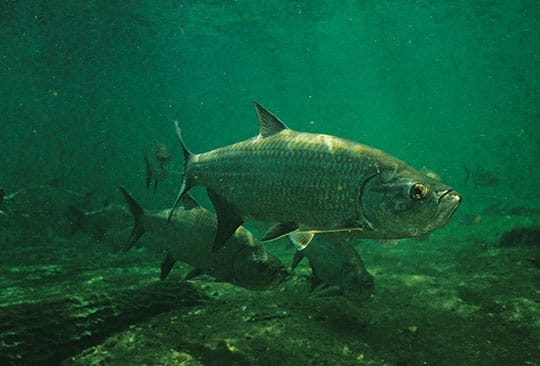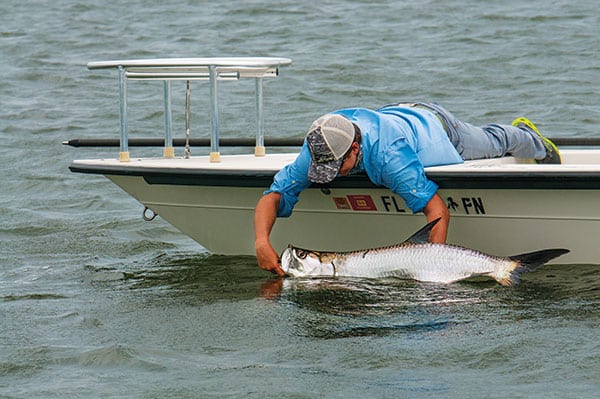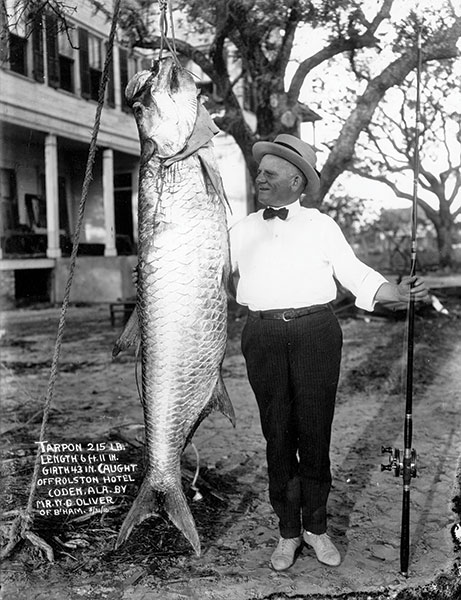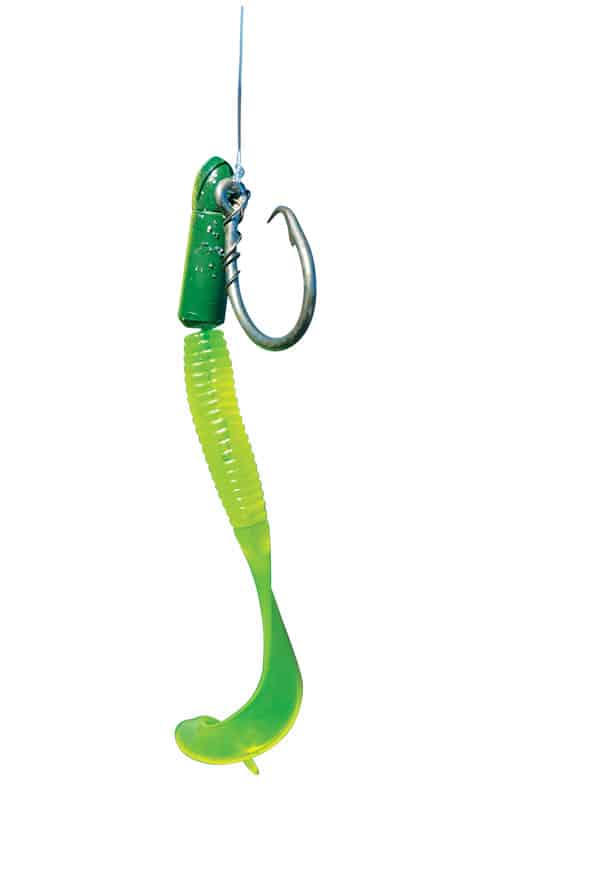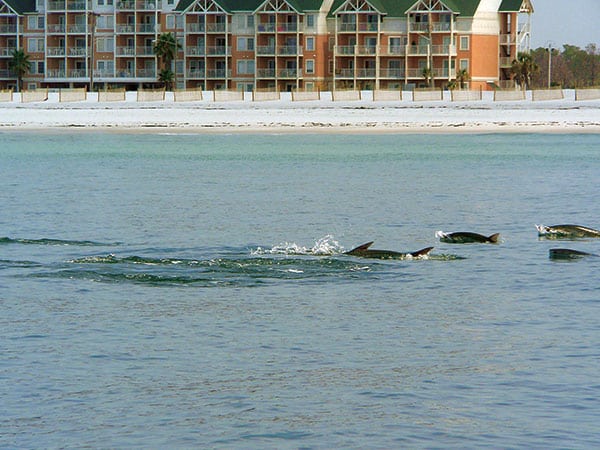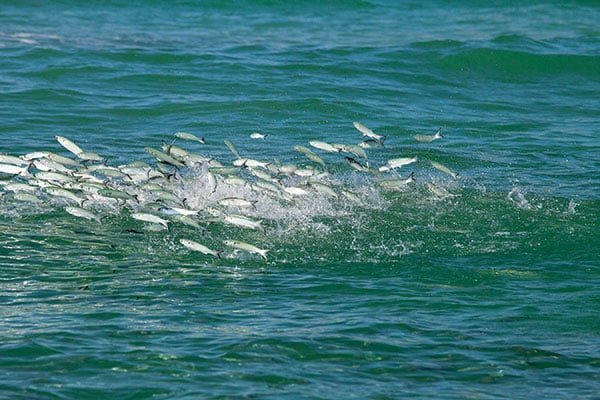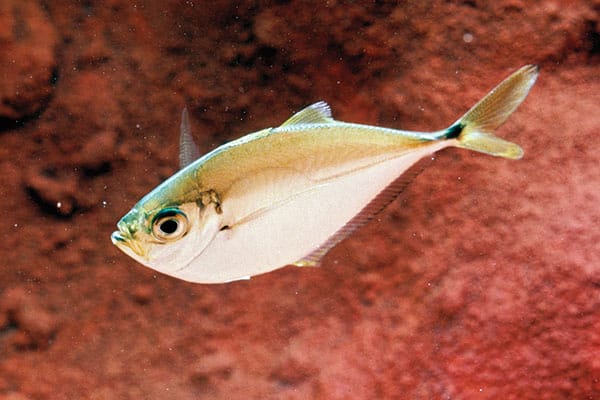Hayden Olds and his partner, Brad Caban, are cruising at about 5 knots in Hayden’s 21-foot Contender off the second sandbar in about 18 feet of water. It’s the middle of June, with a light breeze, flat sea, high sun and excellent visibility.
Olds scans the surface ahead and to the left. Caban focuses on the sea behind them and on the trough between the sandbars to their right. “Fifty yards ahead!” shouts Olds as he pulls back on the throttle. Caban eyes the school a few moments before Olds turns left at a slow speed for about 30 seconds, and then guns the boat hard.
Olds makes a big arcing turn back to the right and -positions the boat on the same line as before, but about a quarter of a mile farther down the beach. He cuts the engine and studies the waters hard astern to spot the oncoming school of tarpon that they have hopefully, and stealthily, cut off.
This scene is a common one off -southwest Florida beaches, but it’s not what most fisher-men, even locals, would likely attribute to the coast of Alabama.
Ask 100 fishermen around Mobile Bay to name the state fish of Alabama, and 95 of them would most likely say speckled trout. Wrong. The state fish is the tarpon. The logo of the Alabama Deep Sea Fishing Rodeo — founded in 1929 and proclaiming itself to be the largest fishing tournament in the world — features leaping tarpon.
Stacking the Deck
You might think, given this broad hint, that more of the 3,000 anglers who participate in the rodeo would concentrate on tarpon. Instead, the vast majority focuses on standard inshore species such as speckled seatrout, redfish, sheepshead, black drum; nearshore species such as Spanish and king mackerel; and reef fishes such as snapper and grouper.
About 20 years ago, Olds and Caban figured out the tarpon angle, and have done consistently well (winning or placing high in several -tournaments over the years).
As most experienced anglers know, catching tarpon is a low-percentage endeavor. Olds and Caban do everything they can to stack the deck in their favor. That means they always have good, hardy baits in the well before they start stalking their prey. Atlantic bumper is the sucker bait. When bumper aren’t available, the anglers pull a switcheroo, cast-netting any good-size threadfin herring, menhaden or mullet.
The pair keeps several rod-and-reel -combinations handy. For drifting live bait, they prefer an 8-foot heavy-duty rod with a Shimano Trinidad 30 or 40 reel, holding 200 yards of 30- or 40-pound mono. Attached to the mono via a 90-pound swivel is a 6-foot, 80- to 100-pound fluorocarbon leader and a 7/0 to 10/0 circle hook. They also carry an 8-foot spinning rod with a reel loaded with 50- to 65-pound braided line; this they use to cast 5- to 6-inch plastic -swimbaits such as D.O.A. Baitbusters.
Right Place at the Right Time
Perdido Pass gives boaters entry to the Gulf at the eastern end of the Alabama beaches in Orange Beach. The coastline runs from about 2 miles east of the pass to the tip of Dauphin Island, about 45 miles west.
Olds and Caban pull out of Perdido Pass at daybreak and look for undisturbed water. The chances of spotting rolling tarpon — which can mean a single tail wag, subtle finning, bubble trails, or boils of water around bait schools — are much better early on, before activity along the beaches cranks up. Personal watercraft, parasail operations and -cigarette boats are not conducive to eyeing these moving targets.
When the team spots any sign of a tarpon school, the game begins. Swing wide to sea; make a big turn and get in front of the oncoming, unsuspecting, early-morning–breakfast-seeking tarpon.
The tarpon hunters put themselves in prime position, facing an approaching school. The tarpon have the short odds now. Olds casts his live bait in front of the school, and one or more of the tarpon goes for it. A big one eats but wants to stay with its pals. Olds is trying to gain line but also puts pressure on the fish to break it out of the pack.
Merely following the fish with the boat does no good. It must strain against the angler, or it’ll just keep swimming all day. The big fish makes several lunges, not coming completely out of the water the way smaller tarpon might.
But it’s gulping air, and that’s not good. Olds tugs at low angles on the fish when it’s near the surface, pulling back down the length of its body, keeping the fish’s head down. Preventing the fish from gulping air will fatigue it more quickly. Actually flipping the fish or making it do a sommersault is disorienting.
These aggressive techniques can -demoralize a tarpon and bring the fight to a quick end. After a 20-minute tussle, Olds brings the silver king to the boat. At that point, he keeps the fish’s head up, preventing it from sounding and continuing the fight. When the fish finally gives up alongside the boat, the team carefully lifts its head out of the water with a Boga Grip for a few seconds and some grinnin’ snapshots. They put the boat in gear and lower the fish’s head back in the water while holding on with the grip, allowing the tired fella to gradually regain its strength.
When conditions are not ideal for spotting rolling and moving tarpon, Caban and Olds will drift along with the current, or anchor at a likely spot. This is usually just off the second sandbar in 18 to 25 feet of water. They’ll deploy several live baits floating under sea corks. In the 2013 rodeo, despite brisk winds and rough seas, Caban brought six tarpon to the boat to take first place in the tarpon category. Olds placed third in the rodeo, bringing two tarpon boat-side. All of the fish were caught on floating live baits.
Tarpon in “America’s Amazon”
When the rodeo was founded, 84 years ago, tarpon abounded in Mobile Bay. Tarpon lodges were sprinkled all about the Alabama coast and its estuaries — Weeks Bay, Bon Secour River and Coden. Industrial and sedimentary pollution steadily degraded Mobile Bay for most of the 20th century. Mullet schools, once so thick in the area that old-timers swore they could walk on them, virtually disappeared, and tarpon fishery naturally declined. In the past 30 years, however, fortunes have improved for the bay, and with that, so has the fishing for silver kings.
These migrating fish often linger in estuarine waters along their route to chow down on abundant forage fish. Since Mobile Bay teems with menhaden in the summer, tarpon detour off the beaches into the bay to chase pogies in late June, and they might well linger until early fall. Prime months for taking tarpon in the bay are July and August.
At 413 square miles, Mobile Bay is the fourth-largest estuary in the United States. It is 31 miles long, and 24 miles across at its widest point. For the most part, the bay is relatively shallow, averaging only 10 feet in depth. Feeding the bay are five rivers that meander through the Mobile-Tensaw Delta, a 270,000-acre virtual wilderness that’s sometimes been dubbed America’s Amazon.
Among the most experienced tarpon -fishermen in Mobile Bay is John Toomey, a lifelong resident of Mobile and an avowed tarpon addict for the past 25 years. Like most Mobile Bay fishermen, Toomey came of age focusing his angling efforts on speckled trout, flounder and redfish, with the aim of filling up his cooler on every outing. But in the late ’80s, after landing several of magnificent silver kings down in the Keys, he was hooked on fishing for them in his own backyard.
Finding the Highways and Byways
On any given weekend, among hundreds of fishermen on the bay, only a handful will be scouting tarpon. As along the beaches in the Gulf, the best chance to take tarpon in the bay requires first spotting them. Flat, calm days are ideal, if not critical, to spy rolling fish. However, after more than 20 years on the hunt, Toomey has a pretty good sense of local tarpon highways and byways.
Toomey’s 25-foot Aquasport, aptly named the Tarpon Tamer, frequently leads the fleet (if you can call a half-dozen boats a fleet) to some of his favorite hot spots. Unlike some of the more-typical fishermen who would rather give up their first born before disclosing a good fishing hole, Toomey’s idea of being a sport fisherman includes bringing more anglers to the party.
The USS_ Alabama_ sits at permanent anchor in the northwestern corner of Mobile Bay, just south of the causeway, at Battleship Park. The ship channel runs just southeast of Battleship Park, and the tarpon hunters will often scout for big fish near the channel between Gaillard Island and the causeway.
Once on a likely spot, Toomey throws out the anchor and begins chumming with chopped-up menhaden. His -equipment is similar than that used by Olds and Caban. Line and terminal tackle are the same as for beach fishing, except for the hook — Toomey favors a big 16/0 circle. Some of the rods will be deployed with live menhaden under a small balloon or sea cork. Other rods will be put out with chunks of menhaden sitting on the bottom, without any weight. Like beach fishermen, Toomey will have one or two casting rods ready to throw his favorite lure, the Coon Pop, at nearby rolling tarpon.
The wind typically blows from the southwest during prime tarpon time in July and August. Navy Cove, an area just inside and to the east of the mouth of Mobile Bay, is sheltered against prevailing southwest winds by the Fort Morgan Peninsula. Baitfish abound in its waters. Navy Cove is a proven hot spot for the rolling tarpon.
Little Secret Lost
Shallow-water fishing for tarpon along Florida’s central Gulf Coast, from Carrabelle to Mexico Beach, is becoming increasingly popular. These same migrating fish are found in abundance from mid-May to mid-July in the shallow waters of St. George’s Sound, Apalachicola Bay and around Cape San Blas before they move into Alabama waters.
For most people, anglers included, Alabama is best known for its intense college-football passion — stoked by Alabama and Auburn winning the last four out of the last five national championships. I’m sure that outside of the middle Gulf states, few anglers know or ever heard of the state’s Deep Sea Rodeo, despite its attracting more than 75,000 spectators. Some vacationers to pristine Alabama beaches know of its spectacular red snapper fishery, where off the coastline, Alabama sports more (mostly artificial) reefs than any other Gulf state.
But tarpon? Still a nice little secret to most, but I’ll bet that won’t be the case much longer.
